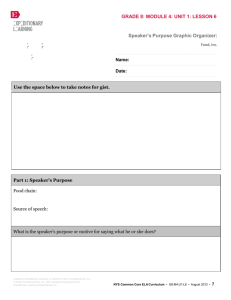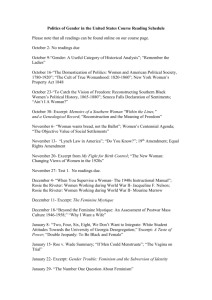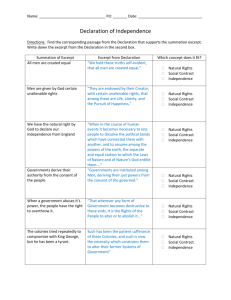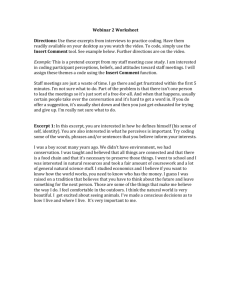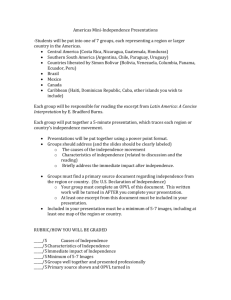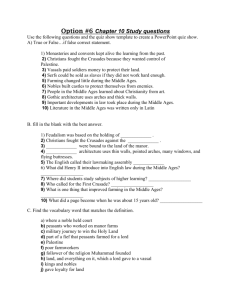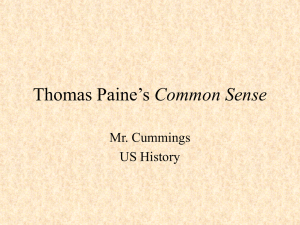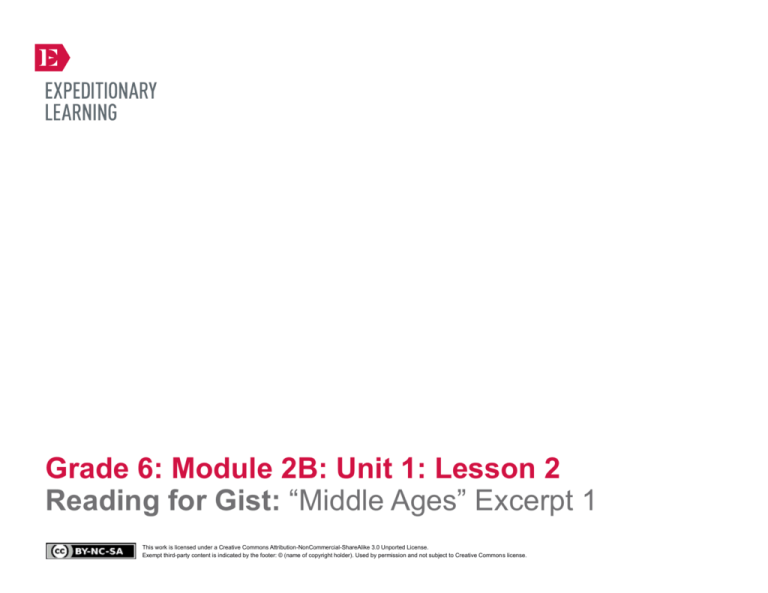
Grade 6: Module 2B: Unit 1: Lesson 2
Reading for Gist: “Middle Ages” Excerpt 1
This work is licensed under a Creative Commons Attribution-NonCommercial-ShareAlike 3.0 Unported License.
Exempt third-party content is indicated by the footer: © (name of copyright holder). Used by permission and not subject to Creative Commons license.
GRADE 6: MODULE 2B: UNIT 1: LESSON 2
Reading for Gist:
“Middle Ages” Excerpt 1
Long-Term Targets Addressed (Based on NYSP12 ELA CCLS)
I can cite text-based evidence to support an analysis of informational text. (RI.6.1)
I can use a variety of strategies to determine word meaning in informational texts. (RI.6.4)
Supporting Learning Targets
Ongoing Assessment
• I can find the gist of Excerpt 1 of “Middles Ages.”
• Digging Deeper into the Text: “Middle Ages” Excerpt 1
• I can determine the meaning of words and phrases in Excerpt 1 of “Middle Ages.”
• I can identify the adversity faced by specific groups of people in Excerpt 1 of “Middle Ages.”
Created by Expeditionary Learning, on behalf of Public Consulting Group, Inc.
© Public Consulting Group, Inc., with a perpetual license granted to Expeditionary Learning
Outward Bound, Inc.
NYS Common Core ELA Curriculum • G6:M2B:U1:L2 • June 2014 • 1
GRADE 6: MODULE 2B: UNIT 1: LESSON 2
Reading for Gist:
“Middle Ages” Excerpt 1
Agenda
Teaching Notes
1. Opening
• This unit builds students background knowledge about adversity in the Middle Ages in preparation for
Unit 2 in which students compare the adversities faced by the people in the Middle Ages in the Good
Masters! Sweet Ladies! monologues, to those we face today.
A. Unpacking Learning Targets (2 minutes)
2. Work Time
A. Reading for Gist (15 minutes)
B. Digging Deeper into the Text: Determining the
Meaning of Words and Phrases
(20 minutes)
3. Closing and Assessment
A. Identifying Adversity (8 minutes)
4. Homework
A. QuickWrite: Reread “Middle Ages” Excerpt 1 and
answer the focus question.
• This is the first lesson in a two-lesson cycle that will be repeated twice in the first half of this unit as a
text about the Middle Ages is introduced in two excerpts. In the first lesson of each two-lesson cycle,
students read the excerpt for gist and dig deeper into the text to build background knowledge about
European people in the Middle Ages. In the second lesson of the cycle, students write a summary of the
excerpt and analyze how part of the text contributes to the whole text.
• Most of the unfamiliar domain-specific vocabulary words have been included in the glossary to ensure
that students have time to grapple with some of the more challenging sentences and phrases to gain a
deeper understanding of the text and to build background knowledge about the Middle Ages.
• After reading for gist, students dig deeper into the meaning of the text by answering questions. Most of
these questions are text-dependent, but some are focused on word and phrase meaning. To ensure
students are able to answer these questions and gain a deeper understanding of the text, this is teacherled with the aid of a Close Reading Guide.
• The closing of the lesson involves having students identify the adversity faced by people in the text
excerpt. This is to bring the focus of the lesson back to the module focus of adversity, and it will also be
used in the end of unit assessment, when students write an informational essay about the adversities
faced by a particular group of people in the Middle Ages.
• To prepare students to address RI.6.5 in the next lesson, for homework they will do a QuickWrite
analyzing how a part of the text introduces the people of the Middle Ages and prepares us for the
information in the rest of the excerpt. This is preparing students for the mid-unit assessment and will be
discussed in more detail in the next lesson.
• In advance: Familiarize yourself with the text and the Close Reading Guide; prepare the Adversity
anchor chart.
• Post: Learning targets.
Created by Expeditionary Learning, on behalf of Public Consulting Group, Inc.
© Public Consulting Group, Inc., with a perpetual license granted to Expeditionary Learning
Outward Bound, Inc.
NYS Common Core ELA Curriculum • G6:M2B:U1:L2 • June 2014 • 2
GRADE 6: MODULE 2B: UNIT 1: LESSON 2
Reading for Gist:
“Middle Ages” Excerpt 1
Lesson Vocabulary
Materials
adversity; era, land holding, fief,
allegiance, alliance, feudal, politically
divided, realm, social position,
oversaw, had few rights, serf
• “Middle Ages” Excerpt 1 (one per student and one to display)
• Document camera
• Dictionaries (enough for students to share)
• Word Catcher (one per student)
• Equity sticks
• Digging Deeper into the Text: “Middle Ages” Excerpt 1 (one per student and one to display)
• Close Reading Guide—“Middle Ages” Excerpt 1 (for teacher reference)
• Adversity anchor chart (new; teacher-created; see Closing Part A)
• Adversity anchor chart (answers, for teacher reference)
• Homework: QuickWrite 1 (one per student)
Created by Expeditionary Learning, on behalf of Public Consulting Group, Inc.
© Public Consulting Group, Inc., with a perpetual license granted to Expeditionary Learning
Outward Bound, Inc.
NYS Common Core ELA Curriculum • G6:M2B:U1:L2 • June 2014 • 3
GRADE 6: MODULE 2B: UNIT 1: LESSON 2
Reading for Gist:
“Middle Ages” Excerpt 1
Opening
Meeting Students’ Needs
A. Unpacking Learning Targets (2 minutes)
• Invite students to read the learning targets with you:
• Learning targets are a researchbased strategy that helps all
students, especially challenged
learners.
* “I can find the gist of Excerpt 1 of ‘Middles Ages.’”
* “I can determine the meaning of words and phrases in Excerpt 1 of ‘Middle Ages.’”
* “I can identify the adversity faced by specific groups of people in Excerpt 1 of ‘Middle Ages.’”
• Remind students that the gist is what the text is mostly about. Remind them that they were introduced to the idea of
adversity in Lesson 1. Ask:
* “What does adversity mean?”
• Select volunteers to share their responses. Listen for them to say that adversity means “difficulties” or “misfortune.”
Created by Expeditionary Learning, on behalf of Public Consulting Group, Inc.
© Public Consulting Group, Inc., with a perpetual license granted to Expeditionary Learning
Outward Bound, Inc.
• Reviewing the key academic
vocabulary in learning targets can
prepare students for vocabulary
they may encounter in the lesson.
• Posting learning targets allows
students to reference them
throughout the lesson to check their
understanding. The learning targets
also provide a reminder to students
and teachers about the intended
learning behind a given lesson or
activity.
NYS Common Core ELA Curriculum • G6:M2B:U1:L2 • June 2014 • 4
GRADE 6: MODULE 2B: UNIT 1: LESSON 2
Reading for Gist:
“Middle Ages” Excerpt 1
Work Time
Meeting Students’ Needs
A. Reading for Gist (15 minutes)
• Distribute “Middle Ages” Excerpt 1 and display a copy via a document camera. Invite students to silently read along
with you as you read the excerpt.
• Reviewing academic vocabulary
words benefits all students
developing academic language.
Consider allowing students to
grapple with a complex text before
explicit teaching of vocabulary.
After students have read for gist,
they can identify challenging
vocabulary for themselves. Teachers
can address student-selected
vocabulary as well as predetermined
vocabulary upon subsequent
encounters with the text. However,
in some cases and with some
students, pre-teaching selected
vocabulary may be necessary.
• Point out the words in bold type and in the glossary and remind students to use this to help them understand the text.
• Ask students to silently reread Paragraph 1 for the gist. Ask them to discuss with an elbow partner:
* “What is the gist of this paragraph? What is it mostly about?”
• Select students to share their responses. Listen for them to explain that it is mostly about when the Middle Ages were in
time, how they began, and how they ended.
• Invite students to circle any unfamiliar words in the first paragraph. Select volunteers to share the unfamiliar words they
circled and circle them on your displayed text. Address the unfamiliar vocabulary in these ways:
– Ask students to read around the word to see if they can figure out the meaning from the context.
– Invite them to replace the word with another word.
– Invite other students to help by sharing the meaning of the word.
– Ask students to look in the dictionary to identify the meaning and to put the definition into their own words.
• Distribute a Word Catcher for this unit. Invite students to record any unfamiliar vocabulary on this word catcher.
• Ask students to work in pairs to find the gist and circle any unfamiliar vocabulary in each of the remaining paragraphs of the
excerpt. Remind them to discuss the gist with their partner before recording it in the margin.
• Circulate and support students as they work. If some need more support, ask them to practice telling you the gist of a section
before they write it in the margin.
• Refocus whole group. Consider using equity sticks to select students to share the gist of the remaining paragraphs and use
the strategies suggested above to help them determine the meaning of any unfamiliar vocabulary.
Created by Expeditionary Learning, on behalf of Public Consulting Group, Inc.
© Public Consulting Group, Inc., with a perpetual license granted to Expeditionary Learning
Outward Bound, Inc.
• Asking students to identify
challenging vocabulary helps them
monitor their understanding of a
complex text. When students
annotate the text by circling these
words, it can also provide a
formative assessment for the
teacher.
• Consider seating those students who
may struggle near each other in
their pairs so that you can work with
them all in one group if needed.
NYS Common Core ELA Curriculum • G6:M2B:U1:L2 • June 2014 • 5
GRADE 6: MODULE 2B: UNIT 1: LESSON 2
Reading for Gist:
“Middle Ages” Excerpt 1
Work Time (continued)
Meeting Students’ Needs
B. Digging Deeper into the Text: Determining the Meaning of Words and Phrases (20 minutes)
• Questioning students about parts of
the text encourages them to reread
the text for further analysis and
ultimately allows for a deeper
understanding.
• Distribute Digging Deeper into the Text: “Middle Ages” Excerpt 1 and explain that you are going to guide the class
through the questions.
• Use the Close Reading Guide—“Middle Ages” Excerpt 1 (for teacher reference) to guide students through a series
of questions about the text excerpt. Students discuss the answers to these questions with their partner and then share with
the whole class.
Created by Expeditionary Learning, on behalf of Public Consulting Group, Inc.
© Public Consulting Group, Inc., with a perpetual license granted to Expeditionary Learning
Outward Bound, Inc.
• Guiding questions provide
motivation for student engagement
in the topic and give a purpose to
reading a text closely.
NYS Common Core ELA Curriculum • G6:M2B:U1:L2 • June 2014 • 6
GRADE 6: MODULE 2B: UNIT 1: LESSON 2
Reading for Gist:
“Middle Ages” Excerpt 1
Closing and Assessment
Meeting Students’ Needs
A. Identifying Adversity (7 minutes)
• Remind students that in the previous lesson, they were told that this module would be about adversity. Tell them that now
they are going to identify the adversity faced by different groups of people in the excerpt they have just read.
• Capturing whole-class thinking on
an anchor chart ensures quick
reference later in the unit.
• Focus students on the Adversity anchor chart. Ask pairs to discuss:
* “What adversities do people face in Excerpt 1 of ‘Middle Ages’?”
* “What evidence can you quote from the excerpt to support your answer?”
• Select a few pairs to share their thoughts. Record their ideas on the Adversity anchor chart. Refer to Adversity anchor
chart (answers, for teacher reference) as you guide the class.
• Distribute Homework: QuickWrite 1.
Meeting Students’ Needs
Homework
• QuickWrite: Reread “Middle Ages” Excerpt 1 and answer this focus question:
– “The second paragraph states, ‘Many people lived their entire lives in one village or manor. They were born to a certain
social position and stayed in that position. Those who wanted something more had few choices. For all but the wealthiest,
life was extremely hard.’ How does this part of the text introduce the people of the Middle Ages and prepare us for the
ideas in the rest of the excerpt?”
Created by Expeditionary Learning, on behalf of Public Consulting Group, Inc.
© Public Consulting Group, Inc., with a perpetual license granted to Expeditionary Learning
Outward Bound, Inc.
NYS Common Core ELA Curriculum • G6:M2B:U1:L2 • June 2014 • 7
Grade 6: Module 2B: Unit 1: Lesson 2
Supporting Materials
This work is licensed under a Creative Commons Attribution-NonCommercial-ShareAlike 3.0 Unported License.
Exempt third-party content is indicated by the footer: © (name of copyright holder). Used by permission and not subject to Creative Commons license.
GRADE 6: MODULE 2B: UNIT 1: LESSON 2
“Middle Ages” Excerpt 1
1. The medieval period, known as the Middle Ages, covers nearly 1,000 years of European history.
According to some historians, the era began in A.D. 476 when a German chieftain overthrew the
last emperor of the Western Roman Empire. It lasted until about 1500, when the Renaissance, a
period of tremendous innovation, became firmly established throughout western Europe.
Medieval Life
2. Although Europe was politically divided in the Middle Ages, daily life did not vary greatly from one
realm to the next. Medieval society was tightly structured. Many people lived their entire lives in
one village or manor. They were born to a certain social position and stayed in that position. Those
who wanted something more had few choices. For all but the wealthiest, life was extremely hard.
The Manorial System
3. Medieval land holdings ranged from small estates called manors to huge fiefs as big as small
countries. The lord of a large fief, such as a baron, might give individual manors to his knights, in
exchange for their service. Those knights thus became lords of their own small manors. But they
still owed allegiance to the baron.
4. A lord’s word was law on his manor. But knights and barons were often away, fighting battles.
Much of the daily management of the manor fell to the lord’s wife. She oversaw planting, spinning,
weaving, and other activities. She made sure servants did their jobs and ran the household
smoothly. Often she also handled the household financial accounts.
5. But despite these responsibilities, women in medieval times had few rights. They were expected to
obey their husbands and fathers in all things. Upper-class girls were married off early, as a way for
powerful families to form alliances and build their wealth.
6. Most of the people on a feudal manor were peasants who spent their lives working in the fields. A
great many of the peasants were serfs—that is, they were not free. Serfs could not leave their
manor to try and find a better place. They belonged to the manor at which they were born and
could move or change jobs only if their lord gave permission. The lords did not freely give away
their serfs any more than they gave away their land or livestock. When a lord agreed to let one of
his serfs marry a serf from another manor, he usually demanded a payment to make up for the loss.
7. Serfs led difficult lives. They had to till the land of the lord, as well as the strips in the manor
fields in which they grew their own food. They knew little about the world and rarely met anyone
from outside their village. They did not travel, nor could they read.
© 2013 Scholastic Inc. All Rights Reserved.
NYS Common Core ELA Curriculum • G6:M2B:U1:L2 • June 2014 • 9
GRADE 6: MODULE 2B: UNIT 1: LESSON 2
“Middle Ages” Excerpt 1
Glossary:
era – a period of time that has certain qualities or events that happened
land holding – ownership of land
fief – an estate of land owned by someone
allegiance – loyalty
alliance – a union for mutual benefit
feudal – owned by a lord or a baron with peasants and serfs working for him
till the land – work on the land, preparing it for crops, then caring for the crops, then harvesting the
crops.
Cooper, Kenneth S. "Middle Ages." The New Book of Knowledge. Grolier Online, 2013. Web. 20 Aug. 2013.
© 2013 Scholastic Inc. All Rights Reserved.
NYS Common Core ELA Curriculum • G6:M2B:U1:L2 • June 2014 • 10
GRADE 6: MODULE 2B: UNIT 1: LESSON 2
Word-Catcher
A
B
C
D
E
F
G
H
I
J
K
L
M
N
O
P
Q
R
S
T
U
V
W
X
Y
Z
Created by Expeditionary Learning, on behalf of Public Consulting Group, Inc.
© Public Consulting Group, Inc., with a perpetual license granted to Expeditionary
Learning Outward Bound, Inc.
NYS Common Core ELA Curriculum • G6:M2B:U1:L2 • June 2014 • 11
GRADE 6: MODULE 2B: UNIT 1: LESSON 2
Digging Deeper into the Text —“Middle Ages” Excerpt 1
Name:
Date:
I can cite text-based evidence to support an analysis of informational text. (RI.6.1)
I can use a variety of strategies to determine word meaning in informational texts. (RI.6.4)
Directions and Questions
Answers. Use evidence from the text.
Read the first paragraph.
1. According to some historians, when
did the Middle Ages begin? And
when did this era end?
Read this excerpt:
“Although Europe was politically
divided in the Middle Ages, daily life
did not vary greatly from one realm to
the next.”
2. What does this sentence mean?
How would you say this sentence in
your own words?
Read this excerpt:
“Many people lived their entire lives in
one village or manor. They were born
to a certain social position and stayed
in that position.”
3. What does it mean to be born to
certain position and to stay in that
position?
Created by Expeditionary Learning, on behalf of Public Consulting Group, Inc.
© Public Consulting Group, Inc., with a perpetual license granted to Expeditionary
Learning Outward Bound, Inc.
NYS Common Core ELA Curriculum • G6:M2B:U1:L2 • June 2014 • 12
GRADE 6: MODULE 2B: UNIT 1: LESSON 2
Digging Deeper into the Text —“Middle Ages” Excerpt 1
Directions and Questions
Answers. Use evidence from the text.
Read Paragraph 3.
4. If a lord gave a manor to a knight,
what would he expect in return?
Read this excerpt:
“Much of the daily management of the
manor fell to the lord's wife. She
oversaw planting, spinning, weaving,
and other activities. She made sure
servants did their jobs and ran the
household smoothly. Often she also
handled the household financial
accounts.”
5. What responsibilities did the lord’s
wife have? What did she have to do?
Created by Expeditionary Learning, on behalf of Public Consulting Group, Inc.
© Public Consulting Group, Inc., with a perpetual license granted to Expeditionary
Learning Outward Bound, Inc.
NYS Common Core ELA Curriculum • G6:M2B:U1:L2 • June 2014 • 13
GRADE 6: MODULE 2B: UNIT 1: LESSON 2
Digging Deeper into the Text —“Middle Ages” Excerpt 1
Directions and Questions
Answers. Use evidence from the text.
Read this excerpt:
“But despite these responsibilities,
women in medieval times had few
rights. They were expected to obey
their husbands and fathers in all
things. Upper-class girls were married
off early, as a way for powerful families
to form alliances and build their
wealth.”
6. What was expected of women in
medieval times?
Read Paragraphs 6 and 7.
7. What was a serf?
8. What was difficult about the life of
a serf?
Created by Expeditionary Learning, on behalf of Public Consulting Group, Inc.
© Public Consulting Group, Inc., with a perpetual license granted to Expeditionary
Learning Outward Bound, Inc.
NYS Common Core ELA Curriculum • G6:M2B:U1:L2 • June 2014 • 14
GRADE 6: MODULE 2B: UNIT 1: LESSON 2
Close Reading Guide—“Middle Ages” Excerpt 1
(For Teacher Reference)
I can cite text-based evidence to support an analysis of informational text. (RI.6.1)
I can use a variety of strategies to determine word meaning in informational texts. (RI.6.4)
Time: 20 minutes
Directions and Questions
Teaching Notes
Read the first paragraph.
(2 minutes)
Invite students to read Question 1 and discuss the answer
with their partner.
1. According to some historians, when
did the Middle Ages begin? And
when did this era end?
Ask them to underline the answer in the text and to record
the answer in the second column on their Digging
Deeper into the Text: “Middle Ages” Excerpt 1
handout.
Use equity sticks to select students to share their answers
with the whole group.
Listen for students to explain that historians believe the
Middle Ages began in A.D. 476 and ended sometime
around 1500.
Created by Expeditionary Learning, on behalf of Public Consulting Group, Inc.
© Public Consulting Group, Inc., with a perpetual license granted to Expeditionary
Learning Outward Bound, Inc.
NYS Common Core ELA Curriculum • G6:M2B:U1:L2 • June 2014 • 15
GRADE 6: MODULE 2B: UNIT 1: LESSON 2
Close Reading Guide—“Middle Ages” Excerpt 1
(For Teacher Reference)
Directions and Questions
Teaching Notes
Read this excerpt:
(4 minutes)
Invite students to read the excerpt with you.
“Although Europe was politically
divided in the Middle Ages, daily life
did not vary greatly from one realm to
the next.”
Ask them to discuss with their partner:
“What does politically divided mean?”
Select volunteers to share their responses.
2. What does this sentence mean?
How would you say this sentence in
your own words?
Listen for them to explain that it means Europe was
divided according to politics, so people in the same area
supported the same political ideas, but people in another
area supported other political ideas.
Ask pairs to discuss:
“You may have heard this word in fairy stories. What is a
realm?”
Cold call pairs to share their ideas. Listen for them to
explain that a realm is an area ruled by someone, like a
kingdom is an area ruled by a king.
Ask students to read Question 2 and discuss the answer
with their partner before recording it in the second
column.
Select volunteers to share their responses.
Listen for them to explain that it means that life was
pretty much the same from place to place, even though
they were divided by their political ideas.
Created by Expeditionary Learning, on behalf of Public Consulting Group, Inc.
© Public Consulting Group, Inc., with a perpetual license granted to Expeditionary
Learning Outward Bound, Inc.
NYS Common Core ELA Curriculum • G6:M2B:U1:L2 • June 2014 • 16
GRADE 6: MODULE 2B: UNIT 1: LESSON 2
Close Reading Guide—“Middle Ages” Excerpt 1
(For Teacher Reference)
Directions and Questions
Teaching Notes
Read this excerpt:
(3 minutes)
Ask pairs to discuss:
“What is a social position?”
Use equity sticks to select students to share their
responses.
“Many people lived their entire lives in
one village or manor. They were born
to a certain social position and stayed
in that position.”
3. What does it mean to be born to
certain position and to stay in that
position?
Listen for them to explain that a social position is often
based on what you do for an occupation and other
factors, such as how much money you have. For example,
in the Middle Ages there were lords who owned lots of
land and there were peasants who worked on the land.
They are two very different social positions.
Ask students to read Question 3 and discuss the answer
with their partner before recording it in the second
column.
Cold call students to share their responses.
Listen for them to explain that it means that you were
born into one level of society and stayed there. For
example, if you were born a peasant, you stayed a
peasant.
Created by Expeditionary Learning, on behalf of Public Consulting Group, Inc.
© Public Consulting Group, Inc., with a perpetual license granted to Expeditionary
Learning Outward Bound, Inc.
NYS Common Core ELA Curriculum • G6:M2B:U1:L2 • June 2014 • 17
GRADE 6: MODULE 2B: UNIT 1: LESSON 2
Close Reading Guide—“Middle Ages” Excerpt 1
(For Teacher Reference)
Directions and Questions
Teaching Notes
Read Paragraph 3.
(2 minutes)
Ask students to read Question 4 and discuss the answer
with their partner. Invite them to underline the answer in
the text and then to record the answer in the second
column.
4. If a lord gave a manor to a knight,
what would he expect in return?
Use equity sticks to select students to share their
responses.
Listen for them to explain that a lord would expect a
knight to serve them and for allegiance..
Created by Expeditionary Learning, on behalf of Public Consulting Group, Inc.
© Public Consulting Group, Inc., with a perpetual license granted to Expeditionary
Learning Outward Bound, Inc.
NYS Common Core ELA Curriculum • G6:M2B:U1:L2 • June 2014 • 18
GRADE 6: MODULE 2B: UNIT 1: LESSON 2
Close Reading Guide—“Middle Ages” Excerpt 1
(For Teacher Reference)
Directions and Questions
Teaching Notes
Read this excerpt:
(3 minutes)
Invite students to read the excerpt. Ask pairs to discuss:
“What does oversaw mean? Did she do those jobs
herself?”
Select volunteers to share their answers.
“Much of the daily management of the
manor fell to the lord's wife. She
oversaw planting, spinning, weaving,
and other activities. She made sure
servants did their jobs and ran the
household smoothly. Often she also
handled the household financial
accounts.”
5. What responsibilities did the lord’s
wife have? What did she have to do?
Listen for them to explain that oversaw means
“managed,” so she didn’t do those jobs herself; she
managed servants and staff to make sure those jobs were
done.
Ask students to read Question 5 and discuss the answer
with their partner. Invite them to underline the answer in
the text and then to record it in the second column.
Use equity sticks to select students to share their
responses.
Listen for them to explain that she was responsible for the
daily management of the manor; she managed servants
who were doing jobs like planting, spinning, and
weaving; and she was often responsible for the financial
accounts—the money.
Created by Expeditionary Learning, on behalf of Public Consulting Group, Inc.
© Public Consulting Group, Inc., with a perpetual license granted to Expeditionary
Learning Outward Bound, Inc.
NYS Common Core ELA Curriculum • G6:M2B:U1:L2 • June 2014 • 19
GRADE 6: MODULE 2B: UNIT 1: LESSON 2
Close Reading Guide—“Middle Ages” Excerpt 1
(For Teacher Reference)
Directions and Questions
Teaching Notes
Read this excerpt:
(3 minutes)
Invite students to read the excerpt. Ask pairs to discuss:
“What does it mean when it says that women in medieval
times had few rights?”
Cold call pairs to share their responses.
“But despite these responsibilities,
women in medieval times had few
rights. They were expected to obey
their husbands and fathers in all
things. Upper-class girls were married
off early, as a way for powerful families
to form alliances and build their
wealth.”
6. What was expected of women in
medieval times?
Listen for them to explain that it means they weren’t
allowed to make many important decisions for
themselves.
Ask students to read Question 6 and discuss the answer
with their partner. Invite them to underline the answer in
the text and then to record it in the second column.
Use equity sticks to select students to share their
responses.
Listen for them to explain that women were expected to
always obey their husbands and fathers.
Created by Expeditionary Learning, on behalf of Public Consulting Group, Inc.
© Public Consulting Group, Inc., with a perpetual license granted to Expeditionary
Learning Outward Bound, Inc.
NYS Common Core ELA Curriculum • G6:M2B:U1:L2 • June 2014 • 20
GRADE 6: MODULE 2B: UNIT 1: LESSON 2
Close Reading Guide—“Middle Ages” Excerpt 1
(For Teacher Reference)
Directions and Questions
Teaching Notes
Read Paragraphs 6 and 7.
(3 minutes)
Ask students to read Questions 7 and 8 and discuss the
answers with their partner. Invite them to underline the
answers in the text and then record the answers in the
second column of their organizer.
7. What was a serf?
8. What was difficult about the life of
a serf?
Select volunteers to share their responses.
Listen for them to explain that a serf was someone who
belonged to the lord of the manor. Serfs were not free and
could move or change jobs only if the lord gave them
permission. The lives of serfs were hard because they had
to work on the land for the lord, as well as grow their
own food. They didn’t travel, and they couldn’t read.
Created by Expeditionary Learning, on behalf of Public Consulting Group, Inc.
© Public Consulting Group, Inc., with a perpetual license granted to Expeditionary
Learning Outward Bound, Inc.
NYS Common Core ELA Curriculum • G6:M2B:U1:L2 • June 2014 • 21
GRADE 6: MODULE 2B: UNIT 1: LESSON 2
Adversity Anchor Chart
Group of People
Adversity Faced
Created by Expeditionary Learning, on behalf of Public Consulting Group, Inc.
© Public Consulting Group, Inc., with a perpetual license granted to Expeditionary
Learning Outward Bound, Inc.
Evidence from the Text
NYS Common Core ELA Curriculum • G6:M2B:U1:L2 • June 2014 • 22
GRADE 6: MODULE 2B: UNIT 1: LESSON 2
Adversity Anchor Chart
(Answers, for Teacher Reference)
Group of People
Adversity Faced
Evidence from the Text
Knights and
barons
away from home and
family fighting battles
“But knights and barons were often away, fighting
battles.”
Lord’s wife
had to manage the
manor
“Much of the daily management of the manor fell to
the lord's wife. She oversaw planting, spinning,
weaving, and other activities. She made sure
servants did their jobs and ran the household
smoothly. Often she also handled the household
financial accounts.”
Women
Had few rights. They
had to obey their
husbands and fathers
rather than making
decisions for
themselves.
“Women in medieval times had few rights. They
were expected to obey their husbands and fathers in
all things.”
Upper-class girls
were made to marry
someone early
“Upper-class girls were married off early, as a way
for powerful families to form alliances and build
their wealth.”
Serfs
Were not free. They
were owned by the lord
and had to work on the
land. They had to stay
where they were, and
they could not read.
“They were not free. Serfs could not leave their
manor to try and find a better place. They belonged
to the manor at which they were born and could
move or change jobs only if their lord gave
permission.… They had to till the land of the lord, as
well as the strips in the manor fields in which they
grew their own food. They knew little about the
world and rarely met anyone from outside their
village. They did not travel, nor could they read.”
Created by Expeditionary Learning, on behalf of Public Consulting Group, Inc.
© Public Consulting Group, Inc., with a perpetual license granted to Expeditionary
Learning Outward Bound, Inc.
NYS Common Core ELA Curriculum • G6:M2B:U1:L2 • June 2014 • 23
GRADE 6: MODULE 2B: UNIT 1: LESSON 2
Homework: QuickWrite 1
Name:
Date:
Reread “Middle Ages” Excerpt 1 and answer this focus question:
• “The second paragraph states, ‘Many people lived their entire lives in one village or manor. They
were born to a certain social position and stayed in that position. Those who wanted something
more had few choices. For all but the wealthiest, life was extremely hard.’ How does this part of the
text introduce us to the people of the Middle Ages and prepare us for the ideas in the rest of the
excerpt?”
Created by Expeditionary Learning, on behalf of Public Consulting Group, Inc.
© Public Consulting Group, Inc., with a perpetual license granted to Expeditionary
Learning Outward Bound, Inc.
NYS Common Core ELA Curriculum • G6:M2B:U1:L2 • June 2014 • 24

